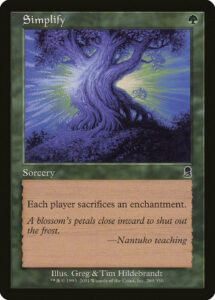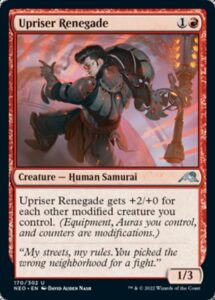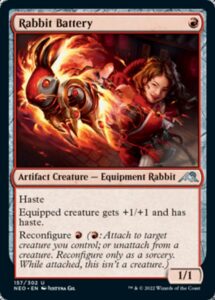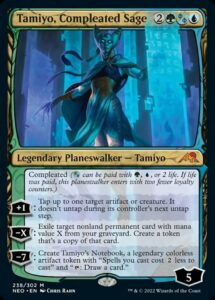Kamigawa: Neon Dynasty is one of the most fascinating sets in recent memory. As with Dominaria, it returned to a long-ignored world and updated it to modern design and worldbuilding sensibilities. But while Dominaria was a generally beloved plane even before 2018, Kamigawa ranked among Magic’s most contentious locales. A return was nigh unthinkable—why would Magic invest the time and energy into an expansion many of its players were liable to write off due to bad experiences or word of mouth? Making Magic is hard enough and there were more popular worlds to revisit, so it seemed an impossible task for Wizards to justify. And yet, with Neon Dynasty, Wizards managed to do the impossible, revitalizing the world and generating one of the most popular Limited formats in recent memory.
There’s much that Neon Dynasty’s success can be attributed to. In this series, we focus in on a set’s new-to-Magic mechanics. In that respect, Kamigawa is once again absolutely fascinating.

A major balancing act
By all accounts, Kamigawa: Neon Dynasty is not a simple set. It features multiple complicated mechanics and incredibly wordy cards. Yet it’s also incredibly streamlined to be engaging without being overwhelming. One of the main ways it manages to do that is through its mechanics.
The set is built around transforming sagas (which are text dense, but their use requires one simple step each turn), Ninjutsu (which adds complexity to one phase of combat, but the complexity is always the same), and Channel (which adds a binary choice to cards, as with Cycling). None of these mechanics are new, so experienced players have a major leg up in understanding the set. In fact, let’s take a quick look at the set’s Limited archetypes:
WU: Vehicles
UB: Ninjutsu
BR: Sacrifice
RG: Modified
GW: Enchantments
WB: Enchantments and Artifacts (the unnamed Harmony mechanic)
UR: Artifacts
BG: Goodstuff with some graveyard
RW: Samurai/Exalted
GU: Channel Ramp
Except for red-green, none of the archetypes are built around new mechanics. Moreover, Neon Dynasty isn’t like Strixhaven, where the entire set was built around new mechanics Magecraft and Learn. The tentpoles that made Neon Dynasty work are artifacts and enchantments (especially sagas), with major contributions by ninjas and Channel.
Neon Dynasty did something extremely unusual by focusing entirely on the interplay between its various elements (all of which comprised of new takes on existing concepts). Instead of using new mechanics as the framework upon which Wizards built the set and with which they featured its novelty, Kamigawa’s new mechanics fill the gaps between its archetypes. In other words, Kamigawa’s new mechanics are workhorse mechanics, and I can’t remember the last time that all of a set’s new mechanics were that. Before the set came out, I’d have been unexcited, but the results were remarkable.

Making changes
Modified was not pushed hard to be powerful. Indeed, red-green was among the least successful color combinations because it had fairly minor synergies. Instead, it serves to combine multiple disparate elements into one, more memorable whole. Your +1/+1 counters? Modifications. Ability counters? Modifications. Your auras with Channel? Yep, they’re modifications. Your Reconfigured creatures? You guessed it.
Modified is a Batching keyword, just like Dominaria’s Historic (the first use of Batching). As with Historic, Modified is the glue that holds the format together, and does so without taking center stage. However, Historic and Modified stand very differently in my memory. I found Historic much easier to remember than Modified. Much of this may be due to execution rather than the mechanics themselves, but context is significant. Historic often triggered on the casting of a specific spell, while Modified checked the battlefield and do so slightly differently depending on whether you were casting Lethal Exploit or Kami’s Flare. Kamigawa has more text on its cards and interactions to remember than Dominaria, making it just a bit harder to track Modifications. And Modified was arguably pushed less than Historic, making it harder to perceive its relative success.
Perhaps the most exciting future application for Modified is as a catchall for future mechanics like “+1/+1 counters matter” or “auras and equipment matter.” Now, they can be unified under a single, deciduous banner to create unity across sets. I think this is unlikely, thanks to Prowess and Mutate. Back in 2014/2015, Prowess was the new blue-red keyword mechanic, ready to give the color pair a reliable, named Limited archetype—and as soon as 2016, the trouble started.
The problem with locking onto a broad definition of what matters? It became harder for cards to signal to players what they wanted to do. If a set is built around instants and sorceries, its cards want to use those words, not “noncreature spells.” And Modified is too broad for sets that just want to care about +1/+1 counters. At the same time, it’s also too specific, since it excludes other forms of modification like Mutate, Transform, Meld, and Threshold.
Overall, I don’t have great things to say about Modified, but sometimes that’s okay. Workhorse mechanics don’t have to be alluring, they just need to get the job done. And while I think one could make an argument that Modified could have been cut from Neon Dynasty without the set suffering for it, I’m not sure how convincing it would be.

Twist on an old standard
While Modified was a bit of glue keeping disparate components together, Reconfigure solved three problems specific to one element: how can you encourage players to play more artifacts, how can you encourage players to play more Modifications, and how can you do both without exacerbating known issues?
The first question is pretty easy to answer: artifact creatures. They’ve been a mainstay of Magic since Alpha, and colored artifact creatures a staple since 2019. The second question is harder. Artifact-based modifications are equipment, so you could just make more equipment. However, this leads us to directly to the third problem, since most decks simply don’t have room for much equipment, if any.
One solution to the third problem is Living Weapon. That gives you the best of both worlds, where players get both a creature and an equipment. However, Living Weapon is a mechanic with built-in card advantage (since you get two things with one card). This means you either have to overpay for your creatures (which is undesirable, especially given Neon Dynasty’s aggressive ninja) or accept a high density of card advantage (a problem alongside the set’s card advantage-generating saga creatures). In addition, equipment can create problems when games go long, since they’re very difficult to remove. And finally, equipment is antisynergistic with vehicles, the other major artifact mechanic in Kamigawa.
Reconfigure elegantly addresses all of this problems by creating a twist on Living Weapon. Instead of overpaying on the upfront cost, most cards had expensive Reconfigure costs. They don’t generate card advantage on their own, though they effectively can do so when the game ran long by equipping creatures. Reconfigure creatures die to creature-based removal, so the set didn’t require large amounts of artifact hate. And because they’re creatures, they work well with vehicles. It’s a grand slam of problem solving. Sure, the mechanic ultimately didn’t prove to be that powerful, but in being a fairer version of equipment, they weren’t meant to be.
I don’t consider Reconfigure’s execution perfect—it plays very differently than Equip and the set had so much going on, it was hard to build the right heuristics. But overall, I’m astounded by both how well it does everything it needs to do as well as it not taking up too much of the spotlight. It’s a big win in my book.

An amuse-bouche
We don’t get mechanics that exist as teasers for the future. Sure, Future Sight did that as a gimmick, but this implementation is surgical. It made it abundantly clear that Magic’s heroes would very soon be facing off against the Phyrexians and made it abundantly clear how high the stakes are. There’s a lot of power in creating a mechanic that says “imagine who will be corrupted,” in getting your players to wonder and perhaps even dread.
As a mechanic, Compleated is a tamed twist on Phyrexian mana. The original incarnation, where you could eliminate a card’s entire colored mana requirement and get a discount, was deeply damaging to the color pie. Now, if you get the mana discount, you both pay life and get a slightly diminished version of the card. And at least with Tamiyo, you still have to pay all associated colors of mana, so there’s no circumventing the color pie.
Time will tell whether and how often this mechanic returns, but I’d expect a few more planeswalkers to be Compleated by this time next year, and for all of them to require payment in full of each of their colors. The only concern I have about the mechanic is its apparent lack of flexibility—if it’s always a choice of one phyrexian mana and two loyalty, it might be hard to get the balance right for four or five different cards. But with only one Compleated card so far, we really don’t know the full affordances of the mechanic.
And, shockingly, that’s it. Kamigawa only has three new mechanics, and one of them only appears on a single card. Somehow, the set managed to be a smash success despite being based on a world of mixed popularity and using no marquee new mechanics. It goes to show just how talented the teams at Wizards are and just how important it can be to eschew obvious choices when the situation calls for it. I’m more impressed by the set now than I was before I started writing this article, and all of it’s due to the impressive restraint behind Neon Dynasty’s mechanics.
Zachary Barash is a New York City-based game designer and the last commissioner of Team Draft League. He designs for Kingdom Death: Monster, has a Game Design MFA from the NYU Game Center, and does freelance game design. When the stars align, he streams Magic (but the stars align way less often than he’d like).

